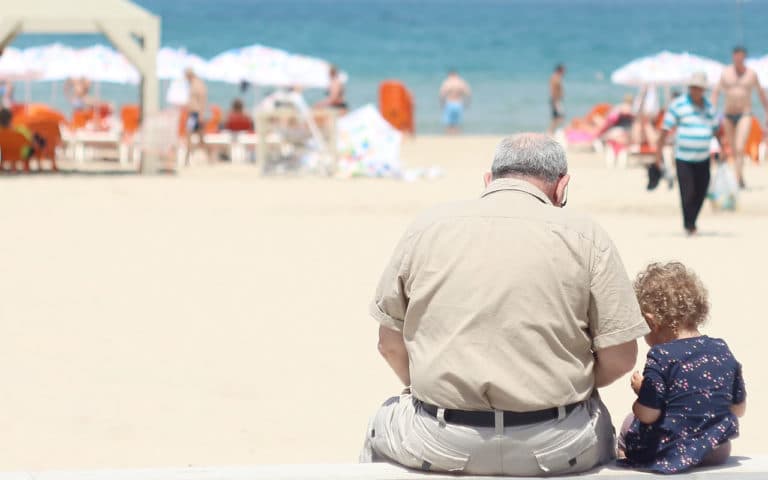I grew up on the Chesapeake Bay and spent every summer splashing through the waves of the Outer Banks. As a child, I wore a swimsuit more often than a dress, grew immune to jellyfish stings, and smelled more like salt water than shampoo.
Then adolescence hit and I stopped swimming.
One day I was a river rat, and the next I was more concerned with how my wet hair would look to the boys on shore, so instead of submerging myself, I spent my days applying Sun-In and watching others have fun.
Once I had my own kids, I spent a lot of time with them in pools and oceans, but I was focused more on their fun and less on my own fitness. I didn’t realize how much I missed the weightlessness of water until I moved far away from the coast to Utah and passed a display of swim goggles in a store one day. On a whim, I bought a pair, along with a swim cap, and headed to our local public pool.
Turns out swimming – like, really swimming – is not at all like riding a bicycle, and by the time I’d done a few laps I was exhausted. My muscles had very little memory of how to do the breast stroke, much less the butterfly, and it took me a while to get into a groove. True story: While fumbling my way across the pool, a very small child passed me in the next lane. When I made it to the other side, I saw that the mother encouraging her from the sidelines was none other than Olympic gold medalist Summer Sanders. Talk about deflating.
Nevertheless, I felt truly happy and satisfied in a vaguely unfamiliar way when I was done. I loved how swimming dulled my senses and stopped me from worrying about work deadlines and school permission slips and current events. Unlike running or even biking, it’s literally impossible to check your phone while swimming.
Which leads me to believe it’s the perfect exercise for caregivers. Five or six years ago when I was balancing two young kids with full-time employment, an aging grandmother, and a deteriorating marriage, the pool was the only place I felt like myself. Just me. Not a frazzled mom. Not a stressed out employee. Not a worried granddaughter. Not a lonely wife.
Swimming doesn’t require a season or a specific time of day. Summer? Swim in a river. Winter? Swim in a pool. It’s a rare opportunity to experience solitude while being surrounded by others. It’s a moment to reflect and recenter. It’s time to just be you.
First things first
As always, check with a doctor before you start a new exercise routine, especially if you have heart, joint, or back pain. You’ll need to take precautions if you choose to swim outdoors, like letting someone know where you’re going, checking weather reports before heading out, and swimming with a buddy in bodies of water that aren’t under a lifeguard’s supervision. And be mindful of the fact that even though you’re under water, you’ll still sweat. Treat swimming like any other workout and be sure to hydrate before and after.
Gearing up
If you’re swimming for real exercise, you’ll want to find a swimsuit that fits well and doesn’t require readjustment. There’s a reason you don’t see bikinis and baggy trunks at Olympic swimming events; opt for a one-piece or snug racing-style bottoms. Invest in quality swim goggles, too, especially if you’re swimming in harsh salt water or chlorinated pools. Finally, a bathing cap is a must if you have long hair. Wash with a clarifying shampoo after exiting the pool and then deep condition to counteract the effects of chlorine.
A basic workout
You’ll get the most bang for your buck if you’re able to swim for at least 30 minutes without rest. That’s a tall order for an adult beginner, so ramp up slowly. Try swimming for 30 seconds, then resting for 30 seconds. Then try a minute of exertion and 30 seconds of rest, and so on. Over time, try to spend more time swimming and less time resting. You’ll also want to employ more than one stroke in your routine to spread the stress out among different muscle groups. Once you’re up to speed, you can attempt five minutes of easy warm-up strokes followed by 20 minutes of more vigorous swimming.
Finding the time
One of the best things about swimming for caregivers is the flexibility. The average community pool has open swim times during early morning hours as well as later in the evening. Go while the household is still sleeping, or slip away while everyone is watching TV after dinner.
Swimming is gentle but challenging. It calms your mind, but also tones your body. It gives your heart a great workout, but won’t stress your joints. If it’s been a while, dip a toe in the water – you might just decide to take the plunge and commit to a new exercise routine.



